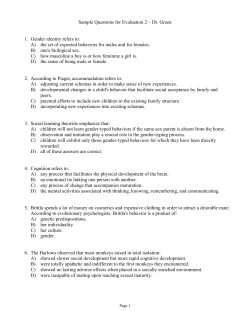
The Children’s Kitchen Task Assessment:
The Children’s Kitchen Task Assessment: Is there a correlation between executive functions and sensory functioning? Diane F. Haas, OTS & Julia Wilbarger, Ph.D., OTR Occupational Therapy Program ~ Department of Kinesiology ~ University of Wisconsin-Madison BACKGROUND • Children with deficits in executive functioning (EF) have difficulties initiating and completing tasks, recognizing inappropriate behavior, and managing the stresses of the school day (Lauth, Heubeck, & Mackowiak, 2006). • Children with difficulties in sensory functioning may also present as having difficulties in task completion, behavior, and success in school (Miller, Anzalone, Lane, Cermak, & Olson, 2007). • Researchers have explored the elements of EF and are beginning to understand the complexities of sensory functioning. At this time there have been no studies that specifically address the relationship between the two constructs. • The aim of this study was to explore the relationship between scores on the CKTA and the SPM by examining variations in the total scores across a typical school age population. RESULTS Correlations between CKTA, SPM, and BRIEF (n=39) SPM Total SPM Planning Score Subtest CKTA Total Score1 -.09 -.01 BRIEF Total Score2 .74** .82** **Correlation is significant at the 0.01 level 1 Spearman’s Coefficient 2 Pearson’s Coefficient Correlation between SPM Total Score and CKTA Total Score SUMMARY • The correlation between total score on the CKTA and total score on the SPM was not significant, r(37) = -.09, p < .05. Nor does the SPM subscale on planning correlate with the total score on the CKTA. • This suggests that the CKTA does not appear to be sensitive to sensory processing functions. Occupational therapists would benefit from administering both the SPM and CKTA to the same child as it provides a more complete picture of their client. • Adding an additional scoring component to the CKTA that is sensitive to both sensory defensive and sensory seeking behaviors may lead to a clearer picture of sensory functioning as it relates to real-life functional performance. • The correlation between total score on the SPM and total score on the BRIEF was significant, r(37) = .74, p<.01. • This indicates that there may be a relationship between executive functions and sensory processing. Additional study with a larger and more diverse sample is needed to confirm and further understand this relationship. STUDY DESIGN & MEASURES • This correlation study design is part of an larger validation study of the CKTA utilizing the Behavior Rating Inventory of Executive Function (BRIEF), an established assessment of EF. • Additional investigation of the data found that the BRIEF subscale on Emotional Control has interesting significant relationships to the SPM subscales on Hearing, Touch, Taste/Smell, Body Awareness, and Balance and Motion. • Study participants consisted of 39 children, 7 to 11 years of age, and their primary caregivers. 18 boys and 21 girls were recruited through several suburban schools in south central Wisconsin. All children who agreed to participate in the study were included regardless of age, race, gender, or socioeconomic status. • Further study of the executive functioning components that utilize emotional control and the five basic senses of hearing, touch, taste, smell, and awareness may lead to a better understanding of the complex relationship between EF and sensory functioning. Measures •The Children’s Kitchen Task Assessment: (Rocke, Hays, Edwards, & Berg, 2008) is a performance-based assessment that evaluates components of executive functions using a fun, safe, and age appropriate activity. Children follow visual and verbal directions in the form of a recipe book and receive a score based on the number of prompts they require to complete the task. Standard cueing guidelines insure consistency among evaluators. •The Sensory Processing Measure Home Form (Parham & Ecker, 2007) is a 75 item survey completed by a parent. Results provide standard scores: Social Participation, Vision, Hearing, Touch, Body Awareness, Balance and Motion, Planning and Ideas, and Total Sensory Systems. •Behavioral Rating Inventory of Executive Function (Gioia et al., 2000) is a parent report measure designed to address the multidimensional nature of 8 sub-domains of the EF construct: Inhibit, Initiate, Organization of Materials, Shift, Working Memory, Monitor, Emotional Control, and Plan/Organize. Correlation between SPM Total Score and BRIEF Total Score REFERENCES Gioia, G. A., Isquith, P. K., Retzlaff, P. D., Espy, K A. (2002). Confirmatory Factor Analysis of the Behavior Rating Inventory of Executive Function (BRIEF) in a Clinical Sample. Child Neuropsychology, 8(4), 249257. Lauth, G. W., Heubeck, B. G., & Mackowiak, K. (2006). Observation of children with attention-deficit hyperactivity (ADHD) problems in three natural classroom contexts. British Journal of Educational Psychology, 76, 385-404. Miller, L. J., Anzalone, M. E., Lane, S. J., Cermak, S. A., & Osten, E. T. (2007). Concept evolution sensory integration: A proposed nosology for diagnosis. American Journal of Occupational Therapy, 61(2), 135140. Parham, D. L., & Ecker, C. (2007). Sensory Processing Measure Home Form. Los Angeles: Western Psychological Services. Rocke, K., Hays, P., Edwards, D., & Berg, C. (2008). Development of a performance assessment of executive function: The children's kitchen task assessment. The American Journal of Occupational Therapy.: Official Publication of the American Occupational Therapy Association, 62(5), 528-537. ACKNOWLEDGEMENTS A sincere thank you to Julia Wilbarger, Ph.D., OTR, University of Wisconsin-Madison Occupational Therapy Department, and the Gertrude Gaston Fund for the financial support to make this project possible. Thank you to Jeanne Appleton, OTR, my research partners, Laura Meitner and Amanda Miller, and all of the children and their caregivers who participated in the study.
© Copyright 2025





















